Hakka Noodles Recipe
Updated: November 3, 2024, By Swasthi
This restaurant style Hakka Noodles is everyone’s favorite. It is a popular Indo-Chinese dish of stir fried noodles, with vegetables and sauces. Vegetable Hakka Noodles are one of the most ordered in the Indian restaurants. But did you know, making them at home is very simple?
In this post, I show you how to make the perfect Indian-Chinese Hakka Noodles that are flavorsome, delicious and have a great crunch in every bite. Make it vegetarian or with a protein of choice – meat, eggs or tofu (details included in the post).
Indo-Chinese Hakka noodles originated from the Chinese population living in Kolkata, India. Over the years it has become a favorite among many Indians. Right from the upscale restaurants to the street carts these are one of the most enjoyed. Unfortunately, the noodles served in most of these places are loaded with oil and msg that dehydrates us a lot. So why not make these at home.
About Hakka Noodles
Hakka noodles are Indian-Chinese style noodles made with unleavened refined wheat flour. These are boiled al dente and then stir fried in a Chinese wok with oil, vegetables & soya sauce. Here Hakka noodles refers to both the final dish and the type of noodles used.
There are a lot of brands selling Hakka noodles. You may buy something from a trusted brand you prefer. I have used Ching’s vegetarian Hakka noodles but you can also use egg noodles from any brand.
Table of contents
Since these are made from refined flour, I try to limit these. If you are trying to avoid refined foods you may use any other whole grain noodles like soba noodles, ramen or udon noodles.
Soba noodles are super thin and made with buckwheat. I use them often to make my vegetable noodles. Udon noodles are fat and thick but made with whole wheat. Somen are super thin noodles made with wheat flour. I have used them in this chili garlic noodles recipe.
Though these are not used in the authentic Hakka noodles recipes, you can still use them if you want to eat healthy and I do that a lot of times.
My Recipe
The restaurant version of Hakka Noodles is pretty basic and is made with minimal use of soya sauce & vinegar. Most of the deliciousness is from the wok hei, a distinct smoky aroma that comes from stir frying the ingredients on a high heat, over an open flame.
Most restaurants use aromat powder or MSG for a flavor boost. However I have not used it in this recipe and never felt the need because the dish turns out good even without the MSG. So to replicate the restaurant flavors, focusing on 4 things is essential:
- Stir fry on a high heat and use a wok.
- Cook the noodles just right – al dente and avoid overcooking.
- Julienne the vegetables thin and long, to match the size of noodles. This comes by practice.
- Avoid using too many sauces to let the smoky flavor shine through. However if you prefer saucy noodles you can transform this to street style hakka noodles with the use of chili garlic sauce. If you don’t have that, feel free to use any hot sauce of your choice.
What to serve with Hakka Noodles
These noodles have plenty of flavor, so at you can eat them on their own. But in restaurants Hakka Noodles are usually eaten with a side of Manchurian or Chili dishes like
Gobi Manchurian
VegManchurian
Paneer Manchurian
Chili Paneer
Chili Chicken
Chicken Manchurian.
Ingredients & Substitutes
Vegetables: Cabbage, French beans, bell peppers, carrots, scallions/ spring onions, regular onions are most commonly used for this recipe. You can use whatever you have. I always feel cabbage adds a great crunch and great aroma to the Hakka noodles. However I have not used it this time since I did not have.
Oil: Use oil that has a high smoke point like peanut, safflower or sunflower oil. High-end restaurants add some toasted sesame oil at the end (after stir frying) to enhance the flavors. But avoid toasted sesame oil for stir frying the hakka noodles as it can leave a bitter taste. This kind of oil is for dressing & salads but not for cooking.
Soya sauce: Choose naturally brewed or organic soya sauce. Avoid using other kinds of soya as they lack the depth of flavor since they are made using harsh chemicals. You can use tamari as a substitute to soya sauce.
Vinegar: Rice vinegar or white vinegar is used to make Hakka noodles. But you can also use apple cider. Avoid using synthetic vinegar.
Spices: Garlic, ginger and crushed pepper are the 3 spices used. These spices add aroma to the noodles without making them taste spicy. I do not use ginger in my recipe. Usually white crushed pepper is used as it is less hot and pungent. I use black ground pepper since I don’t stock up on white pepper.
Chilies: Most Indo-Chinese restaurants use only soya sauce & rice vinegar. The heat comes from the green chilies or the chili oil. Optionally you can use any hot sauce if you like hot spicy noodles. I also use my best homemade Schezwan sauce a lot of times.
Chilli oil is an optional ingredient you can use if you have. Some restaurants use it to enhance the flavors. There are different kinds of chili oil available in the market made with red chilies, Schezwan peppers, garlic etc. You can choose what you like. I have not used any here.
Photo Guide
How to make Hakka Noodles (Stepwise photos)
1. Prepare the following ingredients:
- 1 tablespoon finely chopped garlic from 2 to 3 garlic cloves
- ½ tablespoon very finely chopped ginger – optional (peel first)
- Chop 2 to 3 spring onions/ green onions and separate the greens and whites
- Slice 1 small yellow or red onion to make ½ cup (50 grams)
- Chop 1 green chili (optional, may deseed for low heat)
- Peel and julienne 1 small carrot (½ cup, 50 grams)
- Julienne ½ to ¾ cup (80 grams) capsicum (green/yellow/red bell pepper – any)
- Fine chop 6 French beans / green beans – optional
- Finely shred cabbage to make ½ cup (60 grams) (optional, I did not use)
2. Bring 8 cups water to a rolling boil in a large pot. Add 1 pack (5.5 oz, 150 grams) hakka noodles and cook al dente (a little undercooked). Please follow the pack for the timings. Do not over cook.
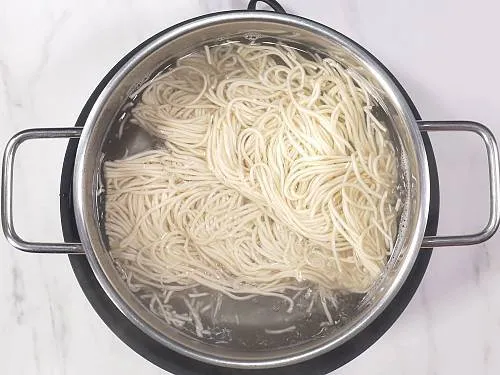
3. Drain them to a colander and rinse under running water. This helps to remove excess starch and keeps the noodles less sticky. Drain completely. Add 1 tsp oil and toss the noodles. This prevents them from turning sticky. Set aside.
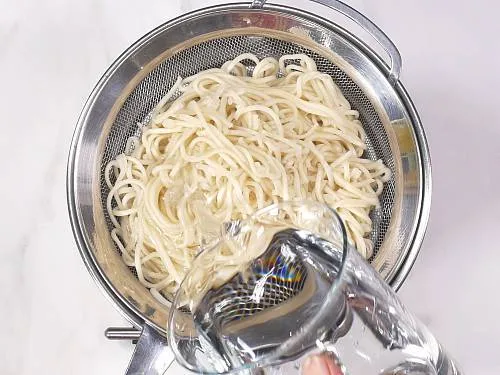
4. In a small bowl, mix together the following and reserve aside
- 1¼ tablespoon organic soya sauce (or tamari)
- 1 teaspoon rice vinegar or apple cider vinegar
- 1 tablespoon hot sauce (Use your favorite sauce) (optional)
- ½ to 1 tablespoon chili oil (optional)
Stir Fry Noodles
5. Heat a wok on a high heat and pour 2 tablespoons oil. Spread the oil all over the wok and add chopped garlic and ginger if using. Fry for just 30 seconds. Add green chilli (optional) and spring onion whites. Saute for 30 seconds more.
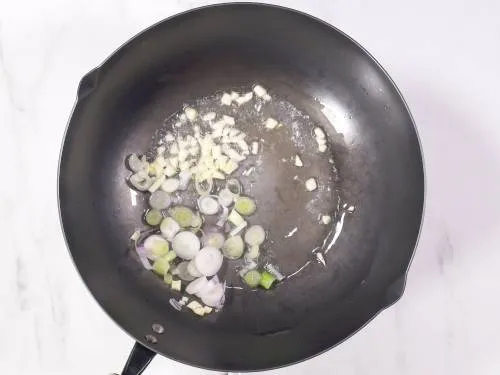
6. Add onions and fry for 1 minute.
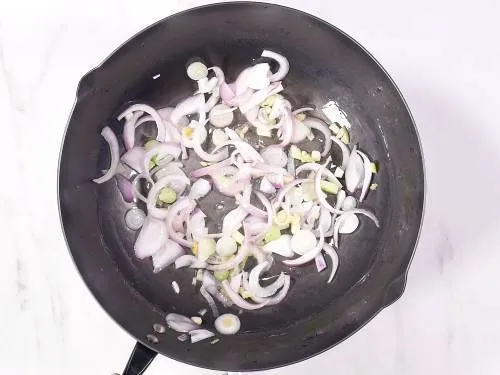
7. Add carrots, capsicum, cabbage and beans. Fry them for just 2 mins until a nice aroma comes out. The veggies should remain crunchy so do not over cook.
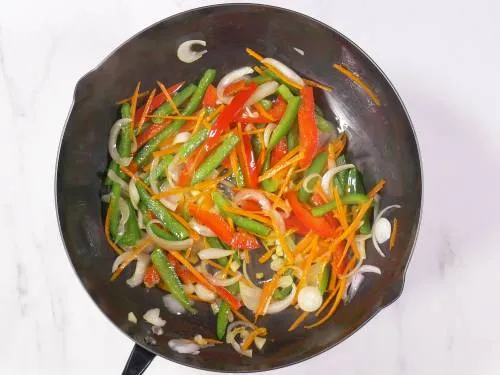
8. Add the noodles, salt and pour the prepared sauce.
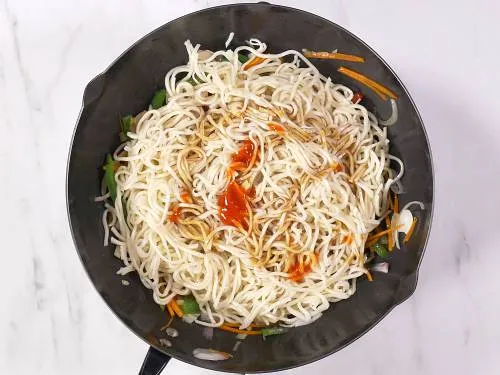
9. Toss well and fry for another 2 minutes. Taste and adjust the sauces and salt at this stage. Add ground pepper and spring onion greens.
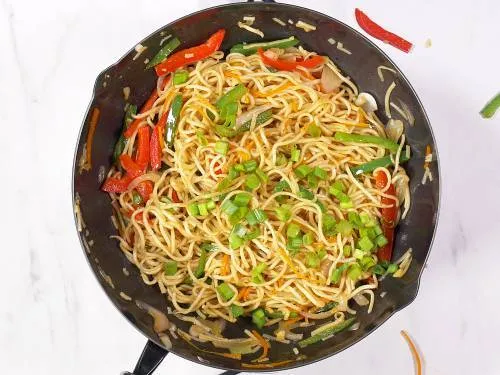
Serve Hakka noodles hot with chilli paneer, gobi manchurian, chilli chicken or chicken manchurian.
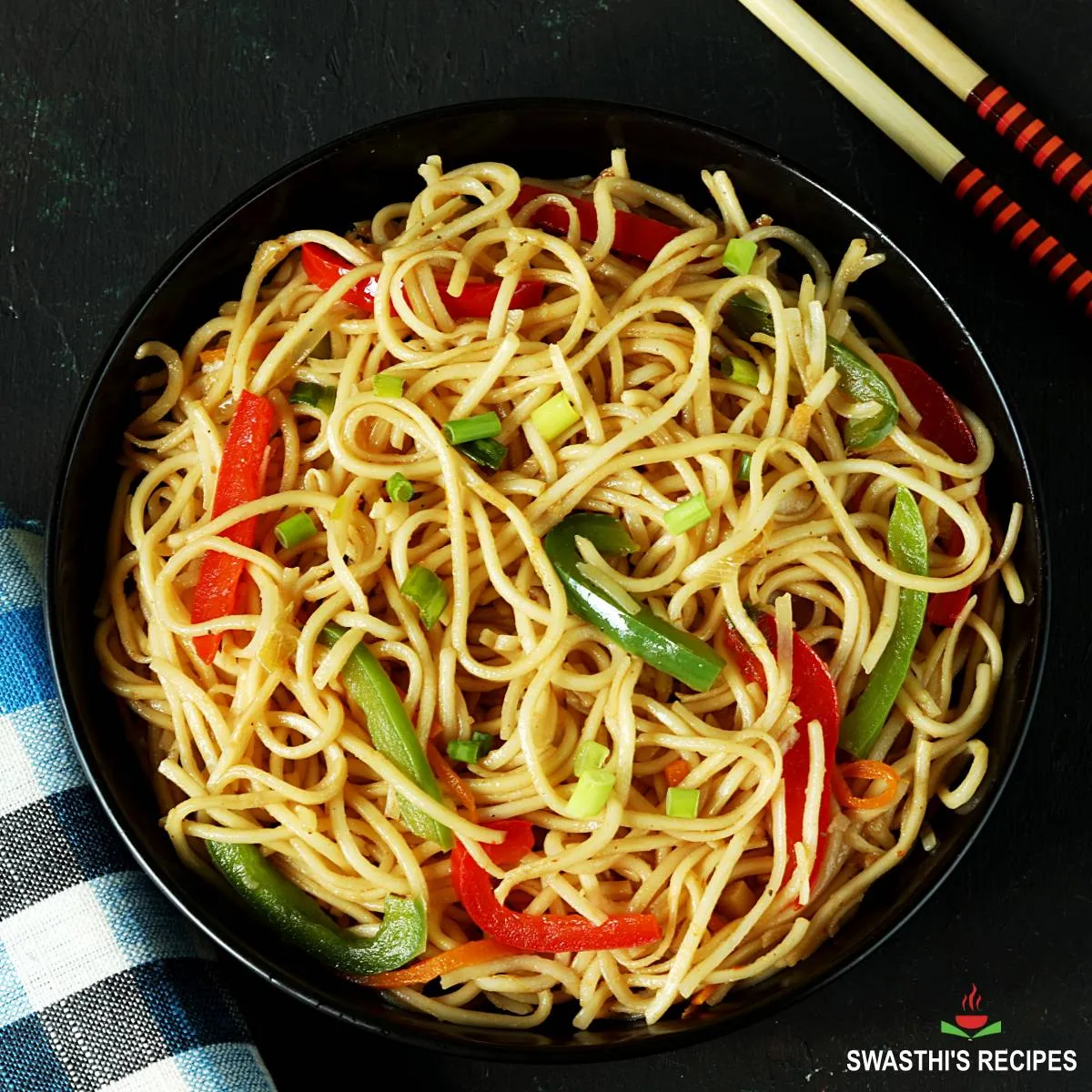
Expert Tips
Prepare veggies: Chop the veggies really thin. If you are a beginner, you may not get it right at the first try. But having those thin slices of veggies really makes a lot of difference as they blend will with the noodles after stir frying. Avoid using too cold veggies as sometimes they let out moisture.
Cook noodles: Avoid over cooking them by all means. For the right texture cook them in plenty of hot boiling water, drain them when they are al dente, meaning they are just cooked and are firm but not too soft. Quickly rinse them under cold running water. This helps in 2 ways – 1. Stops them from cooking further 2. Gets rid of the excess starch.
Prepare noodles: Smear some oil all over the cooked noodles to prevent them from clumping up. This is very important.
Use a wok or a cast iron pan: A large wok is best for making Hakka noodles. If you have a cast iron or a carbon steel wok, do make use of it. These cookware impart that smoky aroma to your Hakka noodles.
Oil: The quantity of oil makes a huge difference here. My recipe does not require lots of oil like the restaurant version so please do not skimp on the quantity of oil. If you are on a low oil diet, cut down your serving size but do not reduce the oil.
I also noticed the carbon steel and the cast iron woks absorb so much of the oil making the noodles dry. So adjust the oil as per your need.
Stir fry on a high flame
Keep the heat/flame high from the start to the end while you stir fry. This imparts a unique smoky flavor to the dish and prevents the veggies from turning mushy.
Stir frying the veggies & Hakka noodles will all take less than 4 to 5 mins since it is done on a high flame. So do attend the pan all the time and keep tossing or mixing with a spatula to prevent overcooking & burning.
Variations with protein of choice
Adjust the amount of sauces and seasoning to your taste.
- Tofu: To a bowl, add 1 tsp soya sauce, black pepper, 1/2 tsp vinegar, 1/2 teaspoon garlic powder, 1/2 teaspoon maple syrup and chili flakes. Add pressed extra firm tofu and coat well. You can marinate for a few hours in the fridge. Pan fry this first until the sauce dries up. Remove and add them as a garnishing.
- Egg Hakka Noodles: Stir in 4 beaten eggs first to 2 tablespoons hot oil & scramble. Cook until the eggs are soft cooked, remove them to a bowl. Proceed with the rest of the recipe. Add back the scrambled eggs along with the noodles and add more sauces to your taste. You can also check this Egg noodles post for step by step photos.
- Chicken Hakka Noodles: Whisk together 1 egg, half tablespoon soya sauce, 1 teaspoon vinegar, 1/4 teaspoon black pepper and 1/4 teaspoon salt. Add 200 grams of chicken strips (3/4 inch size) and coat them well with the egg mixture. Slide in the chicken pieces one after the other to 2 tablespoons hot oil. Stir fry on a high flame until fully cooked, for 3 to 4 mins. Add the remaining egg and cook until done. Remove this to a plate and proceed with the recipe. Add back the chicken along with the noodles. For step by step photos you can also check this chicken noodles.
Related Recipes
Recipe card
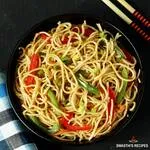
Hakka Noodles Recipe
For best results follow the step-by-step photos above the recipe card
Ingredients (US cup = 240ml )
- 1 pack (5.5 oz, 150 grams) hakka noodles like Ching's or egg noodles or any noodles of choice
- 2¼ tablespoons oil (high smoke point oils like peanut/sunflower/ avocado/coconut or refined sesame oil)
- 1 tablespoon garlic chopped finely
- ½ tablespoon ginger chopped finely – optional
- 2 to 3 spring onion/ green onions (chopped, greens & whites separated)
- 1 small (½ cup, 50 grams) onion sliced thin (yellow or red onion)
- 1 green chilli (chopped, optional)
- 1 small (50 grams) carrot (peeled & julienned)
- ½ to ¾ cup (80 grams) capsicum (green/yellow/red bell pepper julienned)
- 6 French beans / green beans chopped finely
- ½ cup (60 grams) cup cabbage finely shredded (optional)
- 1¼ tablespoon organic soya sauce (or tamari, use more if you want)
- 1 teaspoon rice vinegar (substitute with apple cider)
- ¼ teaspoon black pepper or white pepper, adjust to taste
- ¼ to ½ teaspoon sea salt (adjust to taste)
Optional
- 1 tablespoon hot sauce (or chili garlic sauce, use your favorite sauce) (optional)
- ½ to 1 tablespoon chilli oil (optional)
Instructions
Boil Noodles
- Pour 8 cups of water to a large pot and bring to a rapid boil. Add noodles and cook till al dente. Follow the instructions on the pack for cook time.
- Drain them to a colander and rinse under running water to remove excess starch. Add ¼ tablespoon oil to the noodles and smear it well to prevent them from turning sticky.
- In a small bowl, mix soya sauce, hot sauce, vinegar and chili oil if using. Keep it aside.
How to make Hakka Noodles
- Heat a wok on a high heat and pour oil. Gently coat the oil all over the wok.
- Add garlic and ginger if using. Fry for 30 seconds and add spring onion whites, onions and chili. Fry until the onions turn transparent for a minute.
- Next add carrots, bell pepper and cabbage. Stir fry for 1 to 2 minutes until the veggies are partially cooked yet remain crunchy.
- Add noodles, salt & pour the prepared sauce all over. Toss well and stir fry for about 1 to 2 minutes. Taste test and add more salt or sauces to your taste. Add pepper and spring onion greens.
- Serve hakka noodles hot with gobi manchurian or chilli paneer.
Notes
- Vegetables: Chop veggies really thin & uniform. So they fry faster and blend well with the noodles after stir frying. Avoid using very cold vegetables as sometimes they let out moisture in the pan while frying. Avoid over cooking them in the pan. We want them crunchy.
- Noodles: Avoid over cooking noodles, drain them immediately after they are cooked al dente, meaning just cooked yet firm and not too soft. Rinse them well with cold water and drizzle little oil & spread it all over so they don’t clump up.
- Use a wok or a cast iron pan: The key to making good hakka noodles is a Chinese wok and high flame. If possible use a carbon steel or cast iron wok for the smoky flavors. Stir fry on the highest flame.
- Oil: Do not use too less oil. You won’t get the real restaurant taste without having enough of it. Your cast iron or carbon steel wok takes up some oil so feel free to add a bit more.
- Soya sauce can be substituted with tamari. Use naturally brewed or organic soy sauce.
- For heat you may use chilli oil or green chilli.
- Stir fry on a High flame: Keep the flame high from the start to finish while you stir fry. This imparts a unique smoky flavor to the dish and prevents the veggies from turning too soft.
Video
NUTRITION INFO (estimation only)
© Swasthi’s Recipes
About Swasthi
I’m Swasthi Shreekanth, the recipe developer, food photographer & food writer behind Swasthi’s Recipes. My aim is to help you cook great Indian food with my time-tested recipes. After 2 decades of experience in practical Indian cooking I started this blog to help people cook better & more often at home. Whether you are a novice or an experienced cook I am sure Swasthi’s Recipes will assist you to enhance your cooking skills. More about me
Follow Swasthi’s Recipes

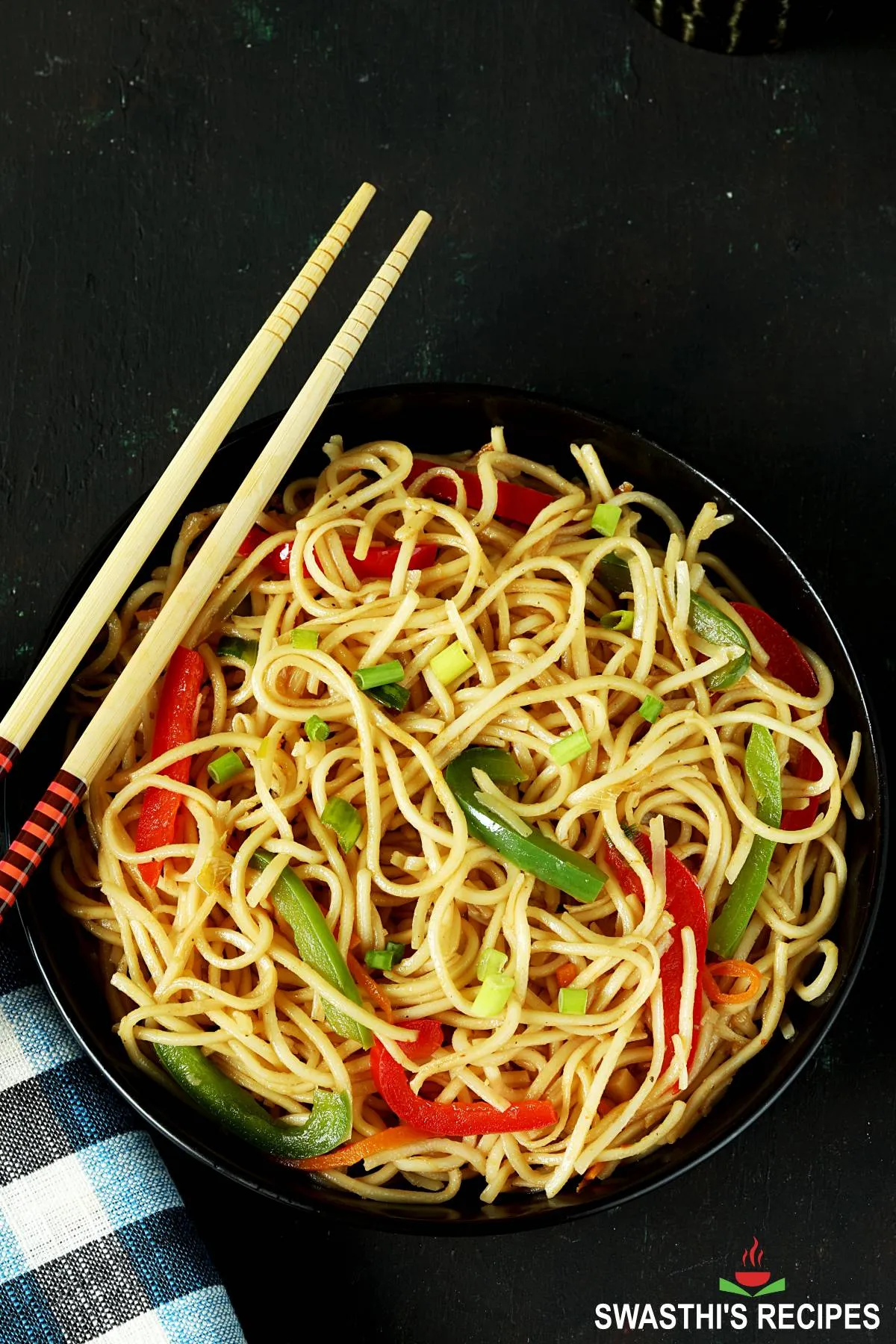
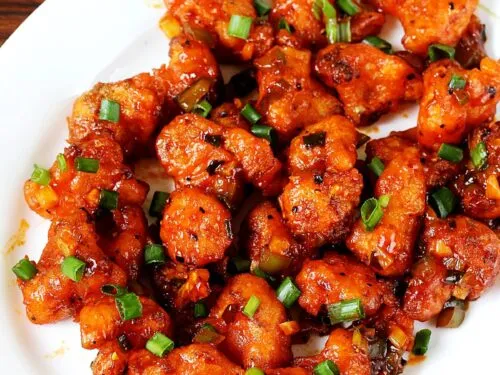
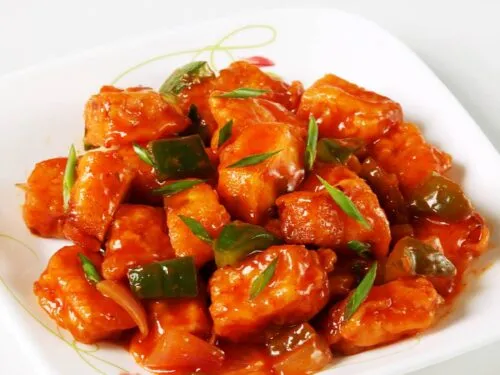
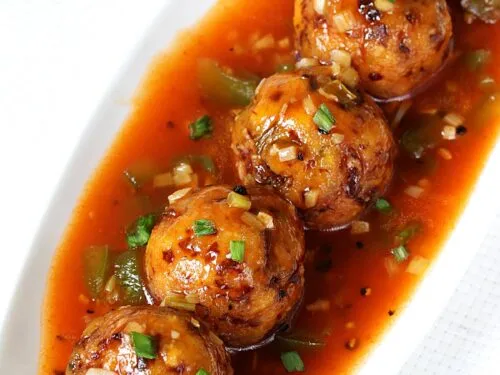
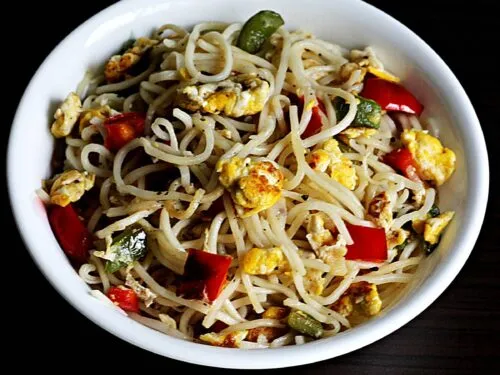
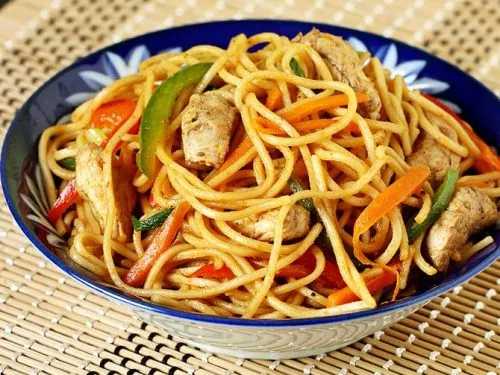
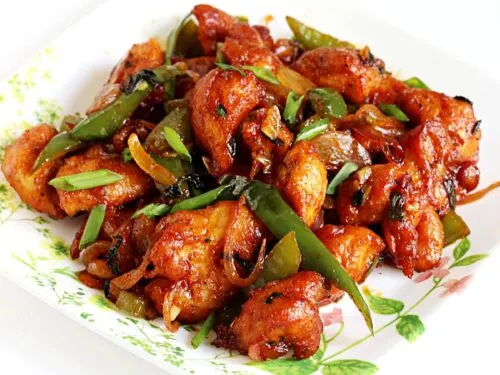
Comments
Fabulous hakka noodles! I used 1 teaspoon of ghost pepper sauce instead of a tablespoon as written in the recipe. It’s a 5 thumbs up! We served it with your chili chicken.
Thanks Adam. That’s great to know! Yes you can adjust the hot sauce to your liking.
It was soo good
Thank you
Brilliant yet simple recipe. Clear directions. I am a beginner cook but was able to achieve great taste with this recipe. Thanks a lot.
I made your hakka noodles twice and my family loved it, including my 3 year old twins. Looking forward to make this with chicken. I have Sichuan oil which I will be using but how would you adjust the sauce and vinegar? Thanks for your reply
Hi Anna,
Thanks for trying. So glad your family loved it. I have updated the details on chicken in the variations section. Hope that helps.
Too good… I love to read your recipes… Beautifully written and well done… All of them gives great taste… God bless swasthi…
Thank you so much Annie for the wishes
Thank you for the awesome recipe.
Came out just like restaurant food…
Glad you like it Gayathri
I loved your recipe, thank you for sharing Swasthi! Everyone loved it from my 1 year old to my mother and father in law who are in their 70s. I can’t wait to try different vegetables in the future like Broccoli.
I didn’t have hakka noodles or Chilli oil but fried half a tsp of crushed Chilli powder before adding 410g of spaghettinni. It still tasted amazing! I appreciate and thank you immensely :). Keep up the great work and I can’t wait to try more of your tasty dishes ?
Omg these hakka noodles are fantastic! I always order when I go out for Indian food to fulfil my Bombay Chinese food cravings. But they are bland most of the times and we serve them with a side of vegetable or paneer manchurian. But this recipe gave me fantastic results and didn’t need any sides. Thank you
I used frozen mixed vegetables instead of fresh. Turned out delicious with a little siracha. Outstanding Hakka!!!
Delicious as always! Love the little tips and variations you provide to make these hakka noodles. I often end up using eggs for a protein-boost and my husband always loves it.
I’ve made this hakka noodles so many times! I love it. I’ve used Chings noodles and sometimes even swapped with spaghetti and it works fine. It is such an easy way to get a restaurant Asian meal on your dinner table.
All your recipes are amazing! I tweak them just a tad per my preferences but everything always turns out so good!
Thank you so much Shreya. So happy to read this!
Followed the recipe exactly and added a little liquid smoke. Turned out amazing.
Thanks Jose, Add a bit of soya sauce on the hot wok (cast iron or carbon steel). You will get the same flavors without liquid smoke. Glad yours turned out amazing.
Not only your recipes but also your cookware is very good. Does your wok have a nonstick layer ? Can you let me know if I can buy one online and from where? TIA
Hi Paromita,
Thank you! It doesn’t have any nonstick coating but works like a non-stick after seasoning with oil. I bought it locally from a store in Singapore. I think you can look on amazon for a similar one.
Easy to follow recipes
Tried recipe and it came out well. Thank you Swasti ji.
Great recipe will try soon
Best one
i am very excited to make hakka noodles the way you explained.i always put sesame oil in beginning but now onwards will use it later.
Thanks for rating the recipe. Hope you like it.
Hey Swasthi
Thank you so much for the recipes. I tried it for our new year dinner. Followed the recipe to the T stirred in some shredded chicken and eggs. Wow! Turned out Delicious! Perfect Hakka noodles like we get in the Indian restaurants. ? ?
Hello Tanya
You are welcome! Glad to know it turned out good.
I also have a separate recipe for chicken noodles, you may want to check it. Pls use the search on the menu bar. Thanks for leaving a comment.